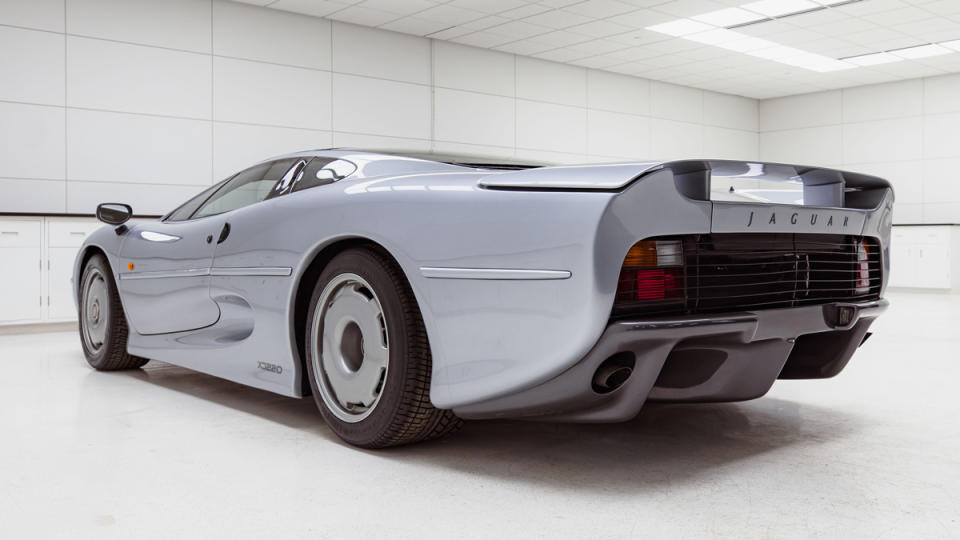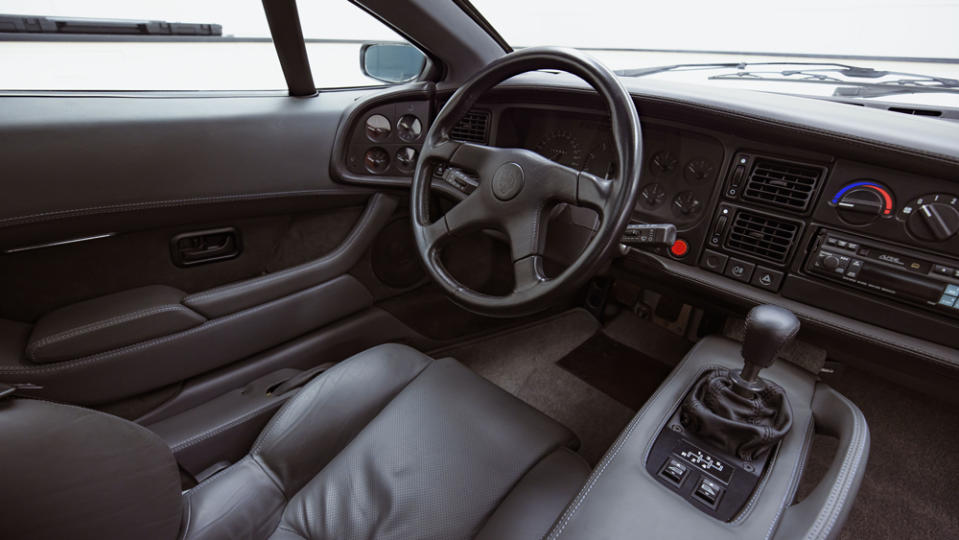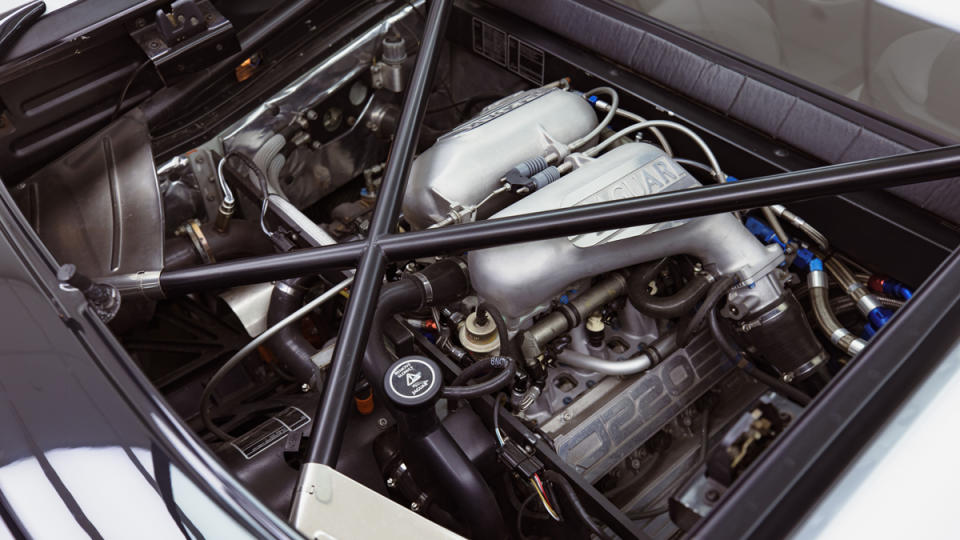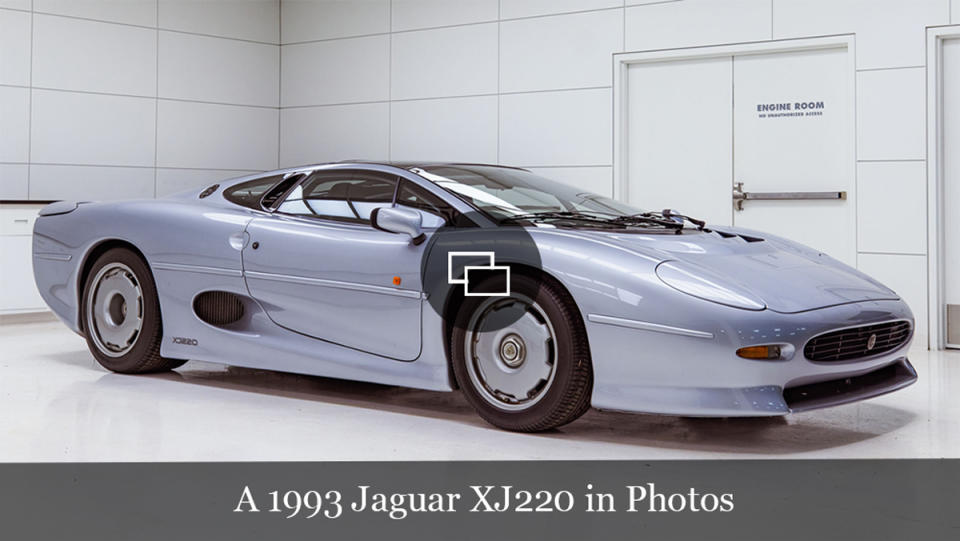Car of the Week: The Jaguar XJ220 Was Once the World’s Fastest Production Car. Now One’s Up for Grabs.

With the final F-Type rolling off the production line this year, Jaguar’s sports-car heritage, at least solely involving the internal-combustion engine, comes to an end. It’s a somber occasion for lovers of the automaker, who will recall landmark models like the first XK120, which debuted in 1948 and whose name referred to the car’s top speed. Although perhaps optimistic, the tradition carried on to the XJ220, what must be regarded as among the most ambitious of Jaguar’s efforts. While the XJ220 achieved a top speed of “only” 218 mph, it was, for a brief time, the world’s fastest production car.
The model was conceived by a small team of Jaguar engineers led by Jim Randle, who worked on the XJ220 after-hours as a project called the “Saturday Club.” Skunkworks projects are nothing new to the world of automotive design; the Lamborghini Miura was the result of a similar effort decades before. Initially developed as an all-wheel-drive Group B competitor to the Ferrari F40 and Porsche 959, the XJ220 saw its design brief change when Ford acquired Jaguar in 1989 and assigned the project to Jaguar Sport, working in collaboration with Tom Walkinshaw Racing (TWR).
More from Robb Report
The Gipsy Moth Plane From 'Out of Africa' Will Be Auctioned Off for Charity This Spring
This Bonkers 1969 Shelby GT350 With a Wild History Is Headed to Auction
Praga's New Supercar Is a Lightweight Track Monster That You Can Also Drive Home

The V-12 engine that was initially intended for the car ultimately gave way to a 3.5-liter, all-alloy turbocharged V-6—a mill used by TWR for the Jaguar XJR-11 racer. While this engine is no attention-grabbing V-12, it develops 542 hp. It also makes the XJ220 quicker from zero to 60 mph than the Ferrari F40, setting a new production-car lap record at the Nürburgring in period.

According to Jaguar Heritage Trust, throughout a limited production run from 1992 through 1994, 281 examples of the XJ220 were made at a purpose-built factory in Oxfordshire. By production’s end in 1994, the car carried a sky-high price of £470,000, though after production ceased, prices fell drastically.

Today, this all-analog supercar is on the ascendency. The assembly of chassis No. 220686 was completed in late September of 1993, and the vehicle was reportedly imported stateside by a Connecticut enthusiast. Subsequently passing through several collections, it was sent to Jaguar Heritage in 2016 for a comprehensive servicing, which included a full engine rebuild, a replacement of the fuel system, a respray in its factory Spa Silver, and a retrim of the interior in Smoke Grey. Invoices for the work done total more than $105,000. In 2021, this XJ220 was acquired by the consignor, who in 2023 commissioned Jaguar Minneapolis to perform an additional $65,000 of service work using OEM parts from the XJ220 specialists at Don Law Racing.

Would-be owners should note that the Jaguar XJ220 is a complicated vehicle requiring attentive maintenance, regardless of mileage, but then, this all holds true for just about any supercar from the era. Showing less than 7,000 kilometers (4,950 miles) on its odometer, the example crossing the auction block is accompanied by more than $170,000 in service receipts, a Jaguar Daimler Heritage Trust certificate, and a workshop manual. This silver bullet will be offered at the RM Sotheby’s Arizona 2024 sale, held at the historic Arizona Biltmore, on January 25, and is estimated to fetch as much as $600,000.
Click here for more photos of this 1993 Jaguar XJ220.
Best of Robb Report
Sign up for Robb Report's Newsletter. For the latest news, follow us on Facebook, Twitter, and Instagram.


